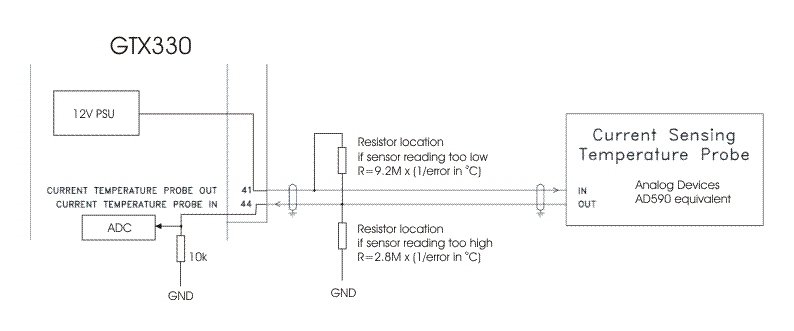
Correcting the GTX330 Temperature Probe Error
The Garmin GTX330 Mode S transponder has an OAT (outside air temperature) probe option. This is very useful because if one's main OAT probe fails, a departure (or continued flight) in potentially icing conditions is not really a good idea... Unfortunately, due to a sloppy design of the transponder circuitry, there is usually a large error - anything up to a few C which can make the feature next to useless.
The following procedure is not approved on an aircraft with an ICAO Certificate of Airworthiness. These instructions were found on the internet and are unverified by myself, but appear totally plausible.
There are several probes around; they use the old 1970s Analog Devices AD590 type sensor, which passes 1 uA per degK i.e. 293.16uA at +20C.
The GTX330 Installation Manual gives 2 probe options
EDMO 655-PROBE
DAVTRON C307PS
which appear to be electrically identical.
To correct for the error, one needs to make it appear that the sensor is passing either more or less current. While it is easy to design a bit of circuitry which passes a specified constant current, it needs a number of components, and is not completely trivial due to the very small currents involved. Fortunately, there is an easy way which takes advantage of the fact that the voltage across the probe is virtually constant, and the temperature range over which high accuracy is really needed is small - around 0C. So one can do it by adding or subtracting a small constant offset current, using just a resistor!
The following is the procedure for a transponder whose temperature indication is too high:
The probe supply has been measured as +12V.
The probe return voltage has been measured as +2.8V. Given the probe passes microamps equal to degrees Kelvin (i.e. 283uA at +20C), it is obvious that Garmin simply drop the current from it across a 10k resistor! The overall installation schematic, showing both possible sensor error adjustment resistors, appears like this

The indication error is probably the result of the tolerance on the 10k resistor (which is probably of 1% accuracy, and 1% here is equal to 2.8C) and the lack of a subsequent calibration of the A-D converter. The actual sensor should be accurate to 1C or better. It is poor form of Garmin to sell a $3000 instrument with this shortcoming because a 3C error is not useful for the determination of an in-flight icing hazard.
Example: Assume the readout is reading 3C too high e.g. +23C when the actual temperature is +20C. You need to get rid of 3C i.e. 3uA and a 1M resistor across this 10k (i.e. from the probe return to GND) will pass 2.8uA which is more or less spot on.
If the indication is too low this means the sensor is not passing enough current, so its current draw needs to be increased. The simplest way is to put a resistor in parallel (as shown in the diagram) with the probe terminals i.e. across the two probe wires. 9 M ohms will increase the reading by 1 degC.
This page last edited 20th January 2010